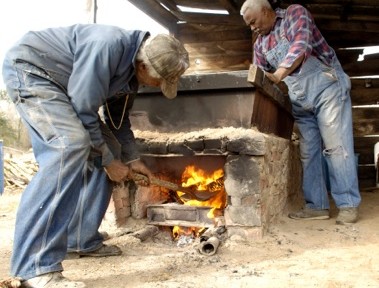Several weeks ago I said I had spent some time stripping sugar cane and then seeing it squeezed out and cooked into syrup. I promised I’d tell you about it, so here it goes.
A friend, Greg Grant, lives in Arcadia out in Shelby County and is from a family that has grown sugar cane for three generations; Greg makes it four. He learned most of what he knows about growing cane from his cousin Rueben. Greg says Rueben is his first cousin, twice removed. But when he started in explaining the details of the varying family relationships, my eyes glazed over; and I just said to myself, “Rueben is his first cousin.” After all, what exactly does ‘twice removed’ mean, anyway? Well, Greg says Rueben grew cane for years, along with tomatoes and mustard greens. Most of these garden crops he sold to area grocery stores or sold the commodities directly to the public himself, but he never made syrup. Rueben would either take the cane he grew to Mr. Willie Swindell, or Mr. Swindell would come get the cane from Rueben. If Rueben took the cane to Mr. Swindell (I refer to Willie Swindell as Mr. Swindell because he is 93 years old and deserves to be called ‘Mr.’), Rueben would get 3/4 of the syrup made. If Mr. Swindell came to Rueben’s place, stripped the cane and hauled it back, then they split the syrup 50-50. Those are the economics of cane growing in Shelby County.
When the cane gets to Mr.Swindell’s hands, the story shifts from Arcadia to Possum Trot, Texas. I’m serious, that’s the name of the place. The handbook of Texas says about Possom Trot, “This small, rural, predominantly black community probably originated in the latter part of the nineteenth century. Important early community centers were the Bennett Chapel Baptist Church and the community water well, which provided water for those who did not live near the springs.”
Well, Willie Swindell learned syrup-making from his mother and father. “They made syrup, and now I make syrup. I do it because I love it,” says Mr. Swindell. And you can tell he does. It’s a family affair. When I went early one cold morning last week, his sister, Pinkie, was there stripping the cane and getting it ready to be cooked into syrup that coming Saturday. I spent an hour or two stripping cane myself, but I could see how this could turn into work if you did it for days on end. When Greg and I showed up the following Saturday, his son was there, Zephaniah, who is a Pentecostal preacher and who seems to project kindness with his every action. Zephaniah says that he helps his father make syrup every fall. It’s a family tradition.
Turning cane into syrup is not an elaborate procedure. The canes’ juices are squeezed out through a mill that consists of several rollers. Mr. Swindell’s mill is powered by a tractor, but he has one on his place that is mule-powered. I didn’t see a mule close by, although there were turkeys, chickens, donkeys and goats.
Once the sweet juices of the cane are squeezed out, the juices are cooked for four or five hours or so. When the juice is heated, the impurities float to the top, and that is when ‘the skimming’ begins. Mr. Swindell cooks his syrup in a large vat that looks similar to a rowboat with a large fire underneath. The fire is fed with rich pine, and the fire gets very hot. As the syrup cooks, it thickens. Greg says Mr. Swindell knows when the syrup is ready. Greg isn’t sure how he knows, but “Swindell knows when he knows.”
If you’ve ever eaten cane syrup, you know that there are few things better than biscuits, butter and cane syrup. There have been seasons in my life when I ate homemade biscuits and cane syrup every day of the week. They were some of the happiest days of my life. I’m not for sure if you could attribute that happiness to the biscuits and syrup; but for the next few months, on a cold day, fix up some homemade biscuits, put butter on them and soak them with cane syrup. You’ll feel better, I’m sure.
(Originally published in The Daily Sentinel Nacogdoches, Texas)

